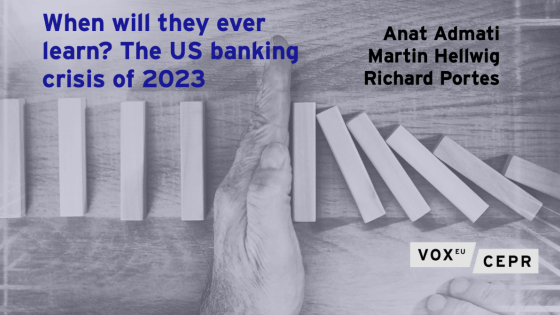Editors' note: This column is part of the Vox debate on "Lessons from Recent Stress in the Financial System"
The collapse of Silicon Valley Bank (SVB) in March, the second largest commercial bank failure in US history, revealed shortcomings in both prudential supervision and resolution of banks in the US. Federal Reserve Vice Chair Michael S. Barr's (2023) report is a valuable acknowledgment and dissection of the supervisory failures that allowed SVB to get into trouble from which it could not escape. But the report glosses over one of the most important: the failure to realise six months ago that SVB was likely to fail and needed to be dealt with by the Federal Deposit Insurance Corporation (FDIC) as resolution authority.
Supervision seeks mainly to detect unduly risky behaviour and to ensure that management takes corrective action. But there comes a point when failure to detect or correct that behaviour results in the materialisation of the risk to the extent that the bank is failing or likely to fail. Such a bank needs to be resolved, using any of a range of procedures available to the public authorities, including liquidation, sale of all or part of its businesses, bail-in of creditors, and so on. It is now clear that in the case of SVB, that point was passed many months before such action was taken.
The role of the lead supervisor in acknowledging the need for resolution should be strengthened. Even then, of course, the exact timing and nature of resolution actions need to be carefully judged to minimise the contagion effect on confidence throughout the system. Not to speak of the spectre of that variant of ‘too big to fail’, namely, ‘too many to fail’.
Three sizable US banks have now failed within a matter of weeks; the Federal Deposit Insurance Fund has incurred considerable losses; and significant amounts of deposits have moved to large banks from regional banks, potentially limiting their customers' access to credit and causing further disruption. There are important lessons to be learnt.
As in other advanced economies, the practice of bank supervision in the US has accumulated an elaborate, legalistic superstructure of procedures, which has slowed corrective action and left several large banks operating openly even though frontline supervisors had enough information to realise that these banks were failing or likely to fail.
Lessons from the Barr report
The Barr report describes an inward-looking and scholastic approach to supervision at the Fed. We see the emphasis given to debate among different teams of experts about where to position each element of the bank's performance on a rating scale with a view to proposing elaborately graduated responses. For example, in November 2022, supervisors decided to downgrade their assessment of SVB's sensitivity to financial market risk from “Satisfactory-2” to “Less-than-Satisfactory-3”; although they did not realise that the bank was hurtling towards failure, it is remarkable that this downgrade was not finalised or issued by the time the bank had failed (page 64).
Reading Barr's report, one can well imagine how the acronym-heavy internal communications and bureaucratic complexity may have inhibited the capacity of senior decision-makers to question supervisory action.
The supervisors don't seem to have warned the board of directors of SVB that the risk appetite statement, which they had approved and which would guide bank staff actions, only checked whether net interest income of the bank would remain satisfactory for 12 months; other standard metrics of risk were flashing red, but the board seemingly wasn't warned (page 62). Echoing many previous reviews, Barr calls out this reluctance on the part of supervisors to act when risks are materializing (page 66).
Deference to bank management and boards is also a factor. As Barr's report makes clear (on page 42), when SVB's growth belatedly triggered heightened Fed scrutiny, the new and presumably more experienced team was reluctant to downgrade the bank suddenly even though they thought it to be in worse condition than had been previously assessed. He suggests that there has been a shift in recent years to the presumption that the burden of proof is on the supervisor rather than the firm. Such a shift undermines the key public policy role of the supervisor, whose function is not just to serve as a management consultant to the bank but in essence to protect society from the consequences of a bank's misuse of its license.
Resolution of banks in the US is primarily the responsibility of the FDIC, and (after a quiet period of years) it is getting a lot of practice these days, and there may be more to come. It will, no doubt, conduct a post-mortem of its handling of the resolution of SVB. Clearly, communications were fumbled as the authorities flip-flopped over how much uninsured depositors would lose.
On 10 March, the FDIC announced that, apart from an advance dividend of unstated size, the large number of uninsured depositors at SVB would have to wait for the receivership of SVB to find out how much they had lost. Three days later, federal authorities announced that all of SVB's depositors would be made whole. All depositors in the other two big banks that failed, Signature and First Republic, are also being protected. The old and thorny question of where the dividing line between officially protected and unprotected depositors should be drawn, brushed under the carpet for several years, has accordingly burst into new prominence (e.g. FDIC 2023).
Equally, if not more, important than the way in which SVB was resolved is the question of timing. Should the FDIC have intervened much earlier, before the depositors started to run, and when it might have been possible to resolve the bank with less disruption? For this, as resolution authority, the FDIC would need to have had a clear indication that the bank was likely to fail, and this information could only be obtained early enough from the supervisors. The FDIC does carry out supervision of banks, but it was not the lead supervisor for SVB – that was the Federal Reserve's role.
Lessons on superisory failure
Supervision seeks improvement, while resolution seeks, well, orderly resolution. A point comes when there is no longer a reasonable prospect of timely remediation of management deficiencies. Given their access to relevant information, bank supervisors might seem to be best placed to realise this. But experience of bank failures worldwide shows that bank supervisors can be reluctant to acknowledge that one of their banks is failing, as that would naturally reflect on their own performance. While willing to identify managerial weaknesses and specify improvements the bank must make (a better risk management plan, the early recruitment of a chief risk officer, and so on), most supervisors are loath to face up to a likelihood of failure.
Consistent with this experience, the response of SVB's supervisors to the bank's deficiencies was always in the direction of seeking specific improvements, never a suggestion that the FDIC should contemplate recovery and eventually resolution action.
Barr does not explicitly point to this gap: the tendency for supervisors to continue hoping for improvements when it is already too late to expect recovery.
Institutional design for the hand-off from supervisor to resolution agency differs from jurisdiction to jurisdiction. It is far from clear what arrangement can minimize the danger of a failing bank not being handed over to those who can resolve it.
In the euro area, an agency separate from the supervisor (the Single Resolution Board, or SRB) has the primary resolution responsibility for systemically important banks. Perhaps the SRB is too far from hands-on relevant supervisory information.
The Bank of England centralises both supervision and resolution, perhaps running the risk of supervisory dominance, since the supervisors have all the information. The Swiss Financial Market Supervisory Authority (FINMA) is also both supervisor and resolution authority, but that did not stop it from intervening in the globally important bank Credit Suisse recently even though the bank was said to satisfy regulatory solvency and liquidity requirements.
The US system, where the resolution authority (FDIC) does get its own supervisory information (though not as lead supervisor), could appear to have the best of both worlds in terms of institutional architecture by separating the resolution decisions from supervision; but it didn't deliver this time.
Just what strengthened approach would help most is hard to say. Ensuring that the resolution authority is fully apprised of the supervisors’ assessment of a bank that seems likely to fail is clearly important. Formal requirements to communicate such assessments are embodied in European Banking Union legislation and that of some other jurisdictions (Svoronos 2018).
Reducing the discretion that supervisors and resolution authorities have to defer action is another device. After the Savings and Loan crisis of the 1980s in the US, Congress mandated “Prompt Corrective Action” when a bank’s capital fell below certain levels. Unfortunately, bank capital as conventionally measured in accounting practice is not a very reliable indicator in times of crisis and at the very least needs to be supplemented by further market-based measures in judging the adequacy of risk-bearing buffers (Admati et al. 2023, Calomiris 2023).
For the same reason, contingent convertible capital instruments (CoCos) that automatically convert to equity when measured capital falls below a certain threshold cannot – even if it is a high threshold – be relied upon to save the bank from a disorderly collapse as other customers or market participants flee.
Besides, the indicators that a bank is heading towards failure are not limited to capital, however measured. There is no avoiding the need for supervisors and by the resolution authority to exercise judgement in making the call that a bank is likely to fail.
As we have seen after the recent events, interventions into a failing bank trigger vigorous push-back from affected parties. Even when it has the necessary information, much therefore depends on the confidence and determination of the resolution authority to take action. Confidence, in particular, that the resolution plan is credibly robust (so that it is not itself destabilising); determination to avoid disorderly and socially costly failure events.
Authors’ note: This is an expanded version of a Peterson Institute for International Economics blogpost.
References
Admati, A, M Hellwig and R Portes (2023), “Credit Suisse: Too Big to Manage, Too Big to Resolve, or Simply Too Big?,” VoxEU.org, 8 May.
Barr, M S (2023), Review of the Federal Reserve’s Supervision and Regulation of Silicon Valley Bank, Federal Reserve Board.
Calomiris, C (2023), “That 80s Feeling: How to Get Serious about Bank Reform this Time and Why We Won’t” VoxEU.org, 27 March.
FDIC – Federal Deposit Insurance Corporation (2023), Options for Federal Deposit Insurance Reform.
Svoronos, J-P (2018), “Early Intervention Regimes for Weak Banks”, FSI Insights on Policy Implementation No. 6.



